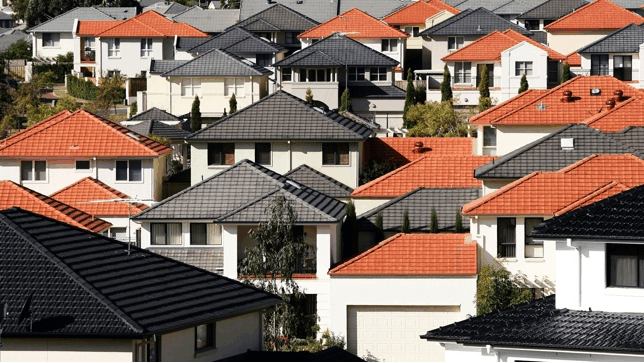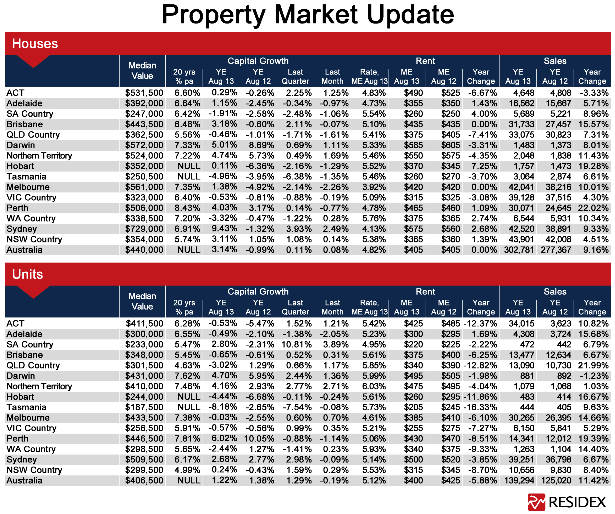
Residex has released its house and unit price results for the month of August, which revealed essentially flat growth in overall home values over the month, with house values rising by 0.08% at the national level, whereas unit values fell by 0.19%. Over the quarter, house values nationally rose by only 0.11%, whereas unit values rose by 1.29% (see below table).

Residex’s price results obviously contradict those of RP Data, which recorded 0.5% growth in dwelling values nationally in August and 4.0% growth over the quarter.
Also interesting is the wide various across capital cities, with all major capital except Sydney recording house price falls in August, and Melbourne house prices falling quite sharply in both monthly and quarterly terms.
According to Residex’s founder, John Edwards, Australian house prices are being driven almost exclusively by investors and first time buyers are being priced-out – an unsatisfactory situation. To solve the problem, Edwards would like to see some form of loan rationing by the RBA and greater provision of infrastructure to new developments. He also supports the macro-prudential measures implemented in New Zealand:
Historically, the Sydney market is the lead indicator for the rest of Australia. It seems that it will again lead other capital city markets into a period of moderate to strong growth. Sydney house price growth was significantly higher in the last 12 months compared to the last three years. However, it is not a boom market and there is no “bubble” forming. It is worth remembering that for the year ending June 2010, Sydney house price growth was 17.17 per cent. Further, growth for the year ending July 2002 was 23.67 per cent and to get even more perspective, house price growth in the “boom” of 1989 was 38 per cent.
We are in a period where interest rates are low. This will be helping investors but for the first home buyer, the cost of housing is still relatively unaffordable. As a result, it is not first home buyers fuelling the current growth in housing values. Additionally, private investors are seeing high risks in the stock market due to the likely wind back of the United States’ quantitative easing monetary policy. As a result, they are looking for low risk, higher yield assets such as housing. To add fuel to the fire, the ability of Self-Managed Super Funds to now structure and use contributions for negatively geared property means a new class of investor is active in the market. In short, the growth period that is underway is being driven mainly by investors in a market where most cities have a shortage of stock.
Australia is going to see further interest rate reductions. Economic growth driven by housing investment is not going to be the saviour of an economy that is transitioning from a mining boom. Australia needs to see small to medium business stimulated strongly and the RBA will be hoping that further rate reductions will have the required effect.
The basic issue is that, while home loans have been reducing, lending rates to small businesses have not reduced sufficiently to be at a stimulatory level unless the loan is secured by housing. Banks are encouraged to maximise lending on residential securities. The capital they have to put aside to support this lending is generally much less than what is needed to support other lending activities. This is a consequence of lower risks associated with home loan lending. In short, this means that profits from home lending are higher compared to others lending activities. In fact, an analysis of the banks’ Pillar 3 disclosures by Mòrgij Analytics shows that the current weighted average risk weighting of the home loan books of the four major banks is 16.4 per cent. This suggests that for every $100 on the mortgage book, the bank only needs to set aside capital of about $1.30. A small business loan on the other hand requires many times this amount of capital to be put aside.
Ultimately, it is not acceptable to create a situation for the current and next generation where housing has a cost that causes them to rent for their entire lives.
Further interest rate reductions will continue to work in the favour of investors as it will increase their capacity to buy and support higher valued homes. This will continue to drive house prices up. Rate reductions will not cause a “bubble” that would “burst” when rates eventually increase because investors are unlikely to default and stock shortages are likely to continue to exist.
There is a feedback loop in all of this. As the investor community acquires additional housing stock and push prices up, they make it virtually impossible for younger people to own their own home. The younger population, by necessity, is forced to rent and hence create demand in the rental market. This, in turn, pushes up rental costs, which once again helps investors as interest rates increase. Also remember that interest costs are tax deductible for investors so rate increases do not have as great of an impact on this group of borrowers compared to a family paying off their home.
Solutions are difficult to implement. In New Zealand, the Central Bank has imposed minimum lending criteria to limit the volume of lending. This does not solve the problem but it helps because as a result, it limits house price growth by reducing demand. However, if this was implemented in Australia I am sure we would quickly see a number of new lenders in the market that are not banks. Hence such an arrangement would need to be carefully worked through so it covered all lenders for residential loans.
I suspect that the only solution for Australia is a market driven response driven by the RBA. That is, the RBA applies measures previously imposed but altered to a more commercial approach – set maximum lending volumes for housing for all parties providing monthly home loans and require banks and all lenders providing home loans to bid and pay for their monthly volume. Perhaps this is a crazy idea but I am at a loss to identify any other method that will not increase risks and limit the growth in housing prices until we solve the real problem, which is providing sufficient infrastructure to allow the development of enough stock to ensure there is not this constant spiralling cost of housing. Perhaps an even crazier idea would be to put the price for the loan allocation volume into an infrastructure fund.

